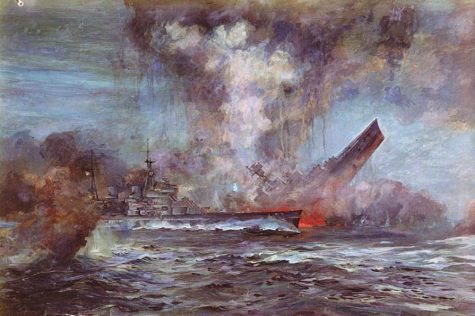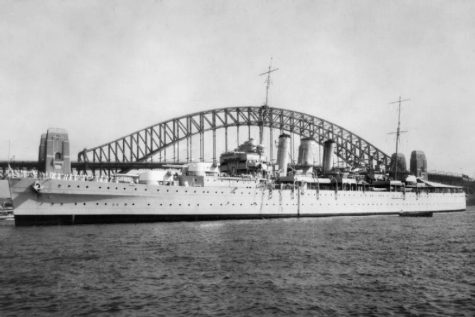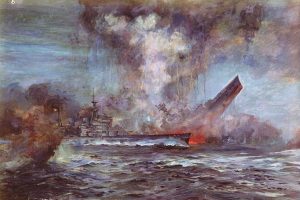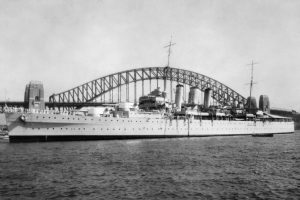Hunt for the Bismarck 75th Anniversary Series: Bismarck is crippled
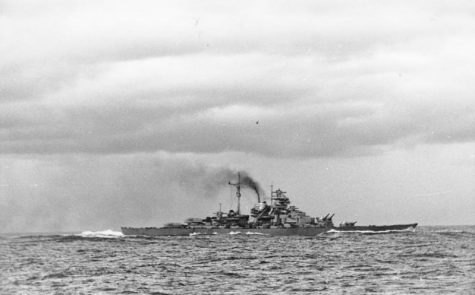
Bismarck after the Battle of the Denmark Straits, taken from Prinz Eugen. Courtesy of the Bundesarchiv.
This is part two in a three-part series.
Bismarck and Prinz Eugen headed towards the Atlantic shipping lanes, their crews feeling prideful over HMS Hood’s destruction.
The next day, May 25, marked Adm. Günther Lütjens’ 52nd birthday. Lütjens received a telegram of congratulations on his birthday and the sinking of Hood from Hitler himself.
Bismarck, however, did not come out unscathed.
During the Battle of the Denmark Straits on May 24, a shell from HMS Prince of Wales struck Bismarck’s forecastle, releasing several thousand tons of fuel into the sea. Bismarck and Prinz Eugen were ordered to slow their speed to conserve oil.
Later that day, a small group of outdated Fairey Swordfish biplanes made a torpedo run on Bismarck, scoring one hit on Bismarck’s armored belt but causing little damage.
Lütjens ordered Bismarck to divert its course and speed toward Nazi-occupied France to take refuge in the port of Brest. Prinz Eugen broke away from Bismarck, in order to reach a German tanker ship and refill her almost empty fuel tanks.
It would be the last time the men of the Prinz Eugen would lay their eyes on Bismarck.
Meanwhile, British naval formation Force H received orders to sail from Gibraltar to intercept the Bismarck. But then the unthinkable happened — Bismarck simply disappeared.
Lütjens, taking advantage of the zig-zagging patterns of the British ships pursuing Bismarck, ordered the ship to double back on its own wake. The British scrambled to try and find Bismarck before it sailed into French waters, where German destroyers and U-boats could cover Bismarck from British ships on the hunt.
To the relief of the Admiralty, on the morning of May 26, a Catalina reconnaissance aircraft spotted Bismarck steaming for French waters.
However, Bismarck was still out of range of Force H and other British warships. Bismarck had to be slowed down.
Later that evening, more Fairey Swordfish aircraft were launched from Force H’s HMS Ark Royal, a British aircraft carrier. The airplanes flew through atrocious weather conditions and high seas to reach Bismarck.

British aircraft carrier Ark Royal with a flight of “Swordfish” overhead, circa 1939.
When the airplanes reached Bismarck, a hail of anti-aircraft fire opened up from the ship. The airplanes were forced to keep low to the water so that Bismarck’s guns could not train on them.
Remarkably, none of the airplanes were shot down, and all made it back to HMS Ark Royal.
John Moffat, one of the Swordfish pilots, launched a torpedo toward the ship. Moffat’s torpedo slammed into Bismarck’s port rudder, jamming it at 12 degrees to port.
Bismarck was crippled.
The crew could not fix the damage and outrun the Royal Navy. Men in diving suits could not work on the rudder due to the high waves threatening to sweep the divers away.
Attempts to steer the ship using its propellers only drove it closer toward the British ships. The situation looked bleak for the ship and its crew as Force H and the rest of the Royal Navy descended upon the German battleship.
Bismarck’s crew realized how bad the situation had developed. Many realized that the Bismarck simply was not going to make it back to Germany.
A bleak, dark feeling hung over the men on board. The officer’s talks of fighting to the end, in an attempt to boost morale, only made matters worse, and actually weakened morale on board.
At 11:40 p.m. later that night, Lütjens signaled to Group West, the German command base, “Ship unmaneuverable. We will fight to the last shell. Long live the Führer.”
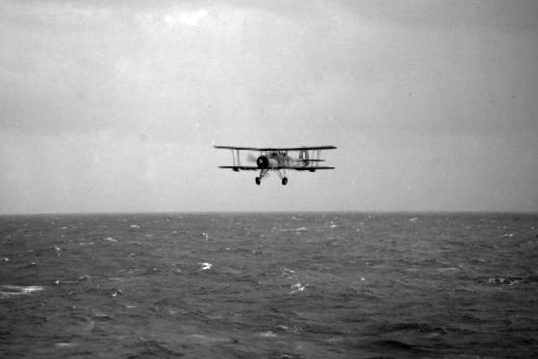
A Fairey Swordfish from the aircraft carrier HMS Ark Royal returns at low level over the sea after making a torpedo attack on the German battleship Bismarck.
Group West replied with “To the crew of the battleship Bismarck: all Germany is with you. What can be done will be done. Your devotion to your duty will strengthen our people in the struggle for their existence – Adolf Hitler.”
Afterward, Lütjens sent a telegram recommending First Gunnery Officer Adalbert Schneider for the Knight’s Cross of the Iron Cross, the German equivalent to the American Medal of Honor, for the sinking of HMS Hood.
The Kriegsmarine granted the award, with Lütjens congratulating Schneider afterward.
Schneider would be killed in the later battle on May 27, when the main gun turret he was in was hit by a British shell.
The men of the Bismarck prepared themselves for the final battle quickly approaching, manning gun positions on board.
The Hunt for the Bismarck was nearing its bloody climax, and its crew could do nothing about it but wait for the inevitable.

Senior
Birthday: April 8, 1999
Extracurricular activities: Robotics, quiz bowl
Hobbies: WWI, WWII, and Civil War reenacting; marching band
...

